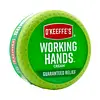What's inside
What's inside
 Key Ingredients
Key Ingredients

No key ingredients
 Benefits
Benefits

 Concerns
Concerns

 Ingredients Side-by-side
Ingredients Side-by-side

Water
Skin ConditioningDipropylene Glycol
HumectantCaprylic/Capric Triglyceride
MaskingEthylhexyl Stearate
EmollientDimethicone
EmollientOryza Sativa Bran Oil
EmollientCoco-Caprylate/Caprate
EmollientSodium Hyaluronate
HumectantBertholletia Excelsa Seed Oil
EmollientOpuntia Tuna Flower/Stem Extract
Skin ConditioningSaccharum Officinarum Extract
MoisturisingTocopherol
AntioxidantGlycerin
HumectantCocos Nucifera Fruit Extract
EmollientLeuconostoc/Radish Root Ferment Filtrate
AntimicrobialParfum
MaskingCandelilla/Jojoba/Rice Bran Polyglyceryl-3 Esters
EmulsifyingPolyglyceryl-3 Methylglucose Distearate
EmulsifyingPolyglyceryl-6 Distearate
EmulsifyingAcrylates/C10-30 Alkyl Acrylate Crosspolymer
Emulsion Stabilising1,2-Hexanediol
Skin ConditioningCetearyl Alcohol
EmollientPotassium Cetyl Phosphate
EmulsifyingTapioca Starch
Acacia Senegal Gum
MaskingSodium Hydroxide
BufferingTetrasodium Glutamate Diacetate
Ethylhexylglycerin
Skin ConditioningPhenoxyethanol
PreservativeBenzaldehyde
MaskingBenzyl Salicylate
PerfumingCoumarin
PerfumingHydroxycitronellal
PerfumingLimonene
PerfumingRose Ketone-4
PerfumingTetramethyl Acetyloctahydronaphthalenes
MaskingWater, Dipropylene Glycol, Caprylic/Capric Triglyceride, Ethylhexyl Stearate, Dimethicone, Oryza Sativa Bran Oil, Coco-Caprylate/Caprate, Sodium Hyaluronate, Bertholletia Excelsa Seed Oil, Opuntia Tuna Flower/Stem Extract, Saccharum Officinarum Extract, Tocopherol, Glycerin, Cocos Nucifera Fruit Extract, Leuconostoc/Radish Root Ferment Filtrate, Parfum, Candelilla/Jojoba/Rice Bran Polyglyceryl-3 Esters, Polyglyceryl-3 Methylglucose Distearate, Polyglyceryl-6 Distearate, Acrylates/C10-30 Alkyl Acrylate Crosspolymer, 1,2-Hexanediol, Cetearyl Alcohol, Potassium Cetyl Phosphate, Tapioca Starch, Acacia Senegal Gum, Sodium Hydroxide, Tetrasodium Glutamate Diacetate, Ethylhexylglycerin, Phenoxyethanol, Benzaldehyde, Benzyl Salicylate, Coumarin, Hydroxycitronellal, Limonene, Rose Ketone-4, Tetramethyl Acetyloctahydronaphthalenes
Water
Skin ConditioningGlycerin
HumectantStearic Acid
CleansingSodium Hydroxide
BufferingParaffin
PerfumingHydroxypropyl Methylcellulose
Emulsion StabilisingAllantoin
Skin ConditioningOctyldodecyl Stearate
EmollientDiazolidinyl Urea
PreservativeIodopropynyl Butylcarbamate
PreservativeAcrylates/Acrylamide Copolymer
MoisturisingParaffinum Liquidum
EmollientPolysorbate 85
Emulsifying
 Reviews
Reviews

Ingredients Explained
These ingredients are found in both products.
Ingredients higher up in an ingredient list are typically present in a larger amount.
Glycerin is already naturally found in your skin. It helps moisturize and protect your skin.
A study from 2016 found glycerin to be more effective as a humectant than AHAs and hyaluronic acid.
As a humectant, it helps the skin stay hydrated by pulling moisture to your skin. The low molecular weight of glycerin allows it to pull moisture into the deeper layers of your skin.
Hydrated skin improves your skin barrier; Your skin barrier helps protect against irritants and bacteria.
Glycerin has also been found to have antimicrobial and antiviral properties. Due to these properties, glycerin is often used in wound and burn treatments.
In cosmetics, glycerin is usually derived from plants such as soybean or palm. However, it can also be sourced from animals, such as tallow or animal fat.
This ingredient is organic, colorless, odorless, and non-toxic.
Glycerin is the name for this ingredient in American English. British English uses Glycerol/Glycerine.
Learn more about GlycerinSodium Hydroxide is also known as lye or caustic soda. It is used to adjust the pH of products; many ingredients require a specific pH to be effective.
In small amounts, sodium hydroxide is considered safe to use. However, large amounts may cause chemical burns due to its high alkaline.
Your skin has a natural pH and acid mantle. This acid mantle helps prevent harmful bacteria from breaking through. The acid mantle also helps keep your skin hydrated.
"Alkaline" refers to a high pH level. A low pH level would be considered acidic.
Learn more about Sodium HydroxideWater. It's the most common cosmetic ingredient of all. You'll usually see it at the top of ingredient lists, meaning that it makes up the largest part of the product.
So why is it so popular? Water most often acts as a solvent - this means that it helps dissolve other ingredients into the formulation.
You'll also recognize water as that liquid we all need to stay alive. If you see this, drink a glass of water. Stay hydrated!
Learn more about Water